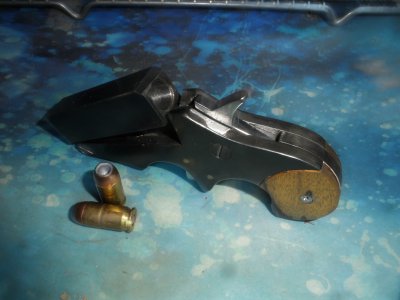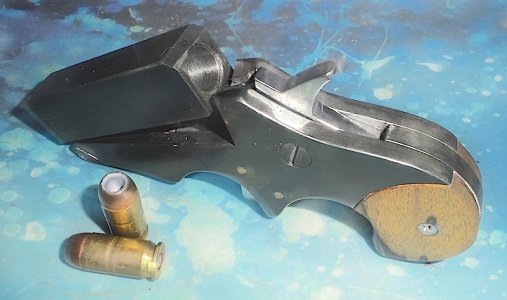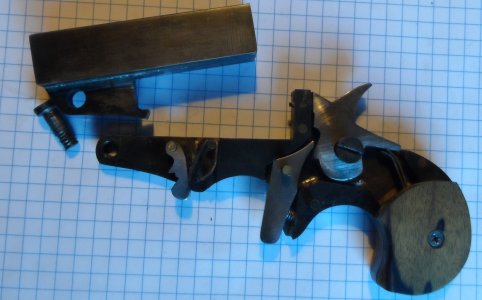- Joined
- Jul 29, 2015
- Messages
- 9
I've watched a lot of Youtube videos about home-made firearms and got the bug to try making one myself. I had an old 1911 barrel sitting around, so I cut off the chamber and bored a new chamber into the muzzle end. Then I sleeved the barrel into a block of 3/4 inch think mild steel, ground and filed a lug on the bottom. The frame is made from three pieces of 1/4 inch 5160 spring steel and is not heat-treated. The parts of the center section were pinned and silver soldered to the right-hand frame. Internal parts were also made from 5160, and springs were made from used bandsaw blades.
Originally I intended to round and contour the edges, but found that I liked its 'blocky' appearance. The extra weight doesn't hurt in terms of managing recoil, either! There is no extractor; cases are driven out after firing by sticking a cleaning rod down the barrel. This can sometimes be a bit difficult (depending on the brand) since my makeshift chamber reamer left something to be desired...
 The result was finished with Birchwood-Casey Super Blue. Making this without a lathe or milling machine has gotten me thinking about getting one or both of these machines!
The result was finished with Birchwood-Casey Super Blue. Making this without a lathe or milling machine has gotten me thinking about getting one or both of these machines!
How does it shoot? Pretty well, actually, though ignition can be unreliable with cheap range ammo. There is also a tendency to string groups vertically. Recoil isn't as bad as I expected- the combination of ergonomics and it's 22 oz. weight soak it up pretty well. The exception was PMC 230 Grain FMCRN ammo- this was hard to ignite, had the worst recoil of any load I tried and I got some bulged primers.
The mainspring is made from three nested sections of bandsaw blade, but I plan on replacing that with a proper clock-spring steel one at some point. This was a fun project and it has me thinking about doing some other more sophisticated guns.
I will say right up front- the gun is not for sale, and was made solely as a hobby project for my own amusement. It was never intended for 'serious' use, just to see if I could do it and for fun.
Originally I intended to round and contour the edges, but found that I liked its 'blocky' appearance. The extra weight doesn't hurt in terms of managing recoil, either! There is no extractor; cases are driven out after firing by sticking a cleaning rod down the barrel. This can sometimes be a bit difficult (depending on the brand) since my makeshift chamber reamer left something to be desired...
 The result was finished with Birchwood-Casey Super Blue. Making this without a lathe or milling machine has gotten me thinking about getting one or both of these machines!
The result was finished with Birchwood-Casey Super Blue. Making this without a lathe or milling machine has gotten me thinking about getting one or both of these machines!How does it shoot? Pretty well, actually, though ignition can be unreliable with cheap range ammo. There is also a tendency to string groups vertically. Recoil isn't as bad as I expected- the combination of ergonomics and it's 22 oz. weight soak it up pretty well. The exception was PMC 230 Grain FMCRN ammo- this was hard to ignite, had the worst recoil of any load I tried and I got some bulged primers.
The mainspring is made from three nested sections of bandsaw blade, but I plan on replacing that with a proper clock-spring steel one at some point. This was a fun project and it has me thinking about doing some other more sophisticated guns.
I will say right up front- the gun is not for sale, and was made solely as a hobby project for my own amusement. It was never intended for 'serious' use, just to see if I could do it and for fun.



